The Ministry of Defence has issued a pre-procurement notice seeking information from industry regarding a future Long Range Anti-Submarine Warfare (ASW) Weapon (LRAW).
Specifically, the Royal Navy is seeking solutions for a Long Range Anti-Submarine Warfare weapon that can deploy Lightweight Torpedoes from Mk41 Vertical Launch System-fitted Type 26 Frigates.
This request for information (RFI) is part of the Royal Navy’s commitment to developing strategic relationships with defence and security industries, in line with the Defence and Security Industrial Strategy (DSIS).
“The Royal Navy is seeking information for a future Long Range Anti-Submarine Warfare (ASW) Weapon (LRAW) that can be launched from surface ship combatants fitted with the Strike-length Mk41 Vertical Launcher System (VLS). The LRAW effector solution will be a ‘missile/rocket’ delivered system – although Uncrewed systems are being examined as potential future ASW enablers.
The LRAW concept provides an extended range delivery means for a Lightweight Torpedo (LWT) or Very Light Weight (VLWT) Torpedo effector against submarine contacts, cued by organic or third-party sensor detection. Engagement ranges are to comfortably overmatch those of current and forecast threat Heavy Weight Torpedoes.
The solution requires an interchangeable, stand-off, quick-reaction, all-weather ASW weapon delivery capability that enables a UK LWT to reach a water-entry point for a targeted submarine from any Mk41 VLS-fitted platform. LRAW will need to integrate with RN Combat or Sonar Systems and must be ‘Secure by Design’.”
The RFI is not a bidding opportunity but aims to gather industry insights. Future procurement activities will adhere to the relevant legislation at the time.
The Royal Navy is looking for solutions for a Long Range Anti-Submarine Warfare (ASW) Weapon (LRAW) that can be launched from surface ships equipped with the Strike-length Mk41 Vertical Launching System (VLS), which is being fitted to the Type 26 Frigates.
The desired system, say the MOD, should deliver a Lightweight Torpedo (LWT) or Very Light Weight Torpedo (VLWT) to engage submarine contacts, using missile or rocket technology. Uncrewed systems are also being considered as potential enablers.
Key requirements for the LRAW include:
- “Extended range delivery to surpass current and projected threat Heavy Weight Torpedoes.”
- “Interchangeable, stand-off, quick-reaction, all-weather capability.”
- “Compatibility with UK LWT for deployment from any Mk41 VLS-fitted platform.”
- “Integration with Royal Navy Combat or Sonar Systems and must be ‘Secure by Design.'”
The Ministry of Defence assumes a global stockpile requirement of 500 missiles for costing purposes. Solutions utilising existing booster designs for payload delivery are also welcome.
What Could This Look Like?
A possible solution to the Royal Navy’s requirements could be the Vertical Launch Anti-Submarine Rocket (ASROC) (VLA) missile.
According to U.S. Naval Sea Systems Command, “The Vertical Launch Anti-Submarine Rocket (ASROC) (VLA) is a surface-ship launched anti-submarine missile designed to deliver the MK 46 Mod 5A (SW) or the MK 54 Mod Lightweight Torpedo to a water-entry point close to a targeted submarine.”
The VLA provides “surface combatants with an all-weather, 360-degree quick-reaction, standoff anti-submarine weapon.” It is currently deployed on Aegis-equipped ships (cruisers and destroyers) with the MK41 Vertical Launching System.
The VLA includes “a solid-propellant booster thrust vector control (TVC) and a digital autopilot control (DAC) to guide the missile from a vertical orientation through a pitch-over manoeuvre into a ballistic trajectory intended to deliver the torpedo to an aim point on the ocean surface.”
This type of system could meet the Royal Navy’s requirement for a long-range, quick-reaction anti-submarine warfare capability, but we will see where this goes.


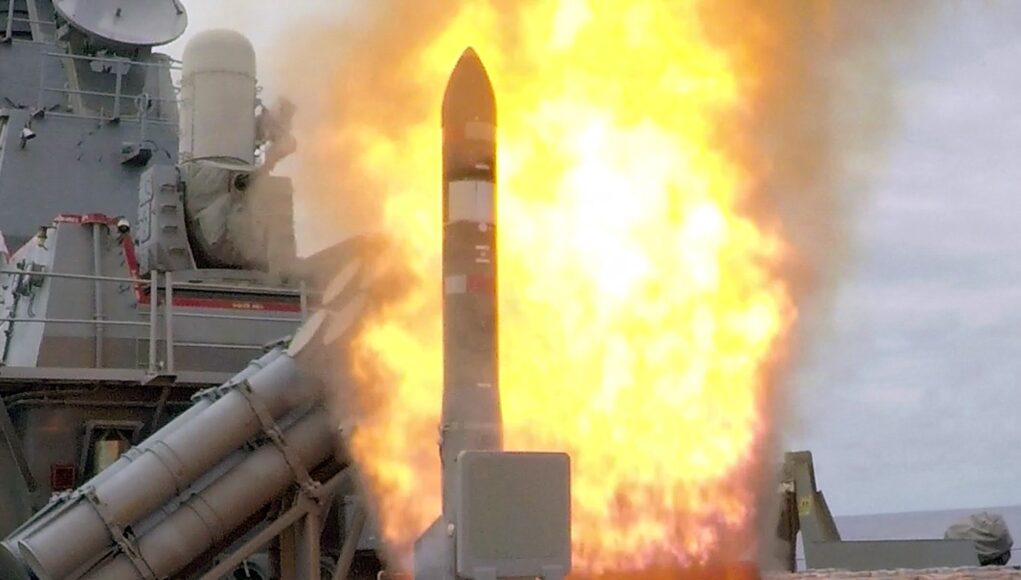


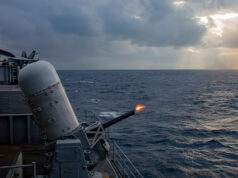
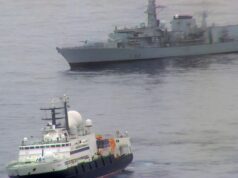

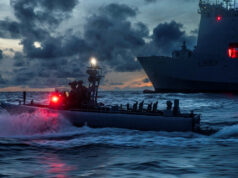

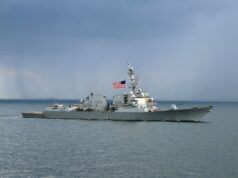
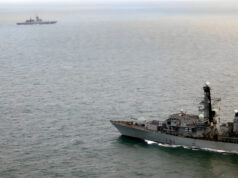
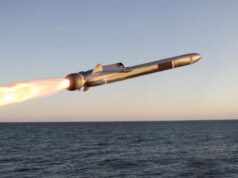

Obviously no guarantee of actually getting it. But at least intresting to see they’re talking about it.
Would VLA be applicable if they’re also looking for whichever weapon to carry UK Torpedoes?
VLA can be adapted to deliver almost any LWT… the question is whether it’s stand-off enough, I.e., if it out ranges existing and future HWT… I don’t think it does. The Indian and Japanese systems on the other hand, do…
What’s the Indian system called, obvs unlikely we’d pick that up but still intresting
Here’s a link… it’s huge, so I don’t know if it would fit into a Mk41 VLS cell, but the infographic shows it being shot from a surface vessel… anyway, over 400 miles of range is a game changer
https://theprint.in/defence/the-smart-torpedo-system-and-why-drdo-is-calling-it-game-changer-in-anti-submarine-warfare/518428/
400 mile range is intresting, especially since the ships it’s launched from won’t be able to detect a target 400 miles away. Do they have an underwater sonar network or maybe just for a spread out CSG
You can find a link here… SMART (missile) – Wikipedia
It’s huge, so I’m not sure it’d fit in a Strike Length MK41 cell, but there are infographics around that show it being launched from a surface vessel, so who knows…
Ah. Intresting, presumably the inidans have a specific VLS system for it or larger missiles.
I would probably add the Italian system to the list. Not vertical launch, but deck canister launched. Easier to add a deck canister system, especially to ships that can’t handle mk41. Otherwise the Japanese system is probably ahead of ASROC & more likely to offer to integrate alternative light torpedoes.
Massive positive that they are considering it, to me this has always been a major weakness of the RN, it’s too reliant on helicopters which can’t operate in all conditions and are not constantly available.
From my experience during ASW tasking we have never had a Helo unavailable. If the weather is to bad to fly it’s to bad to do ASW in anyway.
A Wildcat can carry 2 x torps a merlin 4. Reloads onboard a T23 are deep enough for at least 12 and 6 sorties respectively.
To achieve that out of a VLS… That’s a lot of tubes to use up just for ASW.
Hi Gunbuster,
I believe I am right in saying that the MK41 VLS systems come with 8 ‘tubes’ and one control box with each system. As such the minimum load out for any type of weapon is 8. (Although I note that the Flight I and II Arleigh Burke had two MK41 silos of 29 and 61..? All subsequent ships had multiples of 8.)
T26 is set to have 24 ‘tubes’ or 3 systems. So if they put ASW weapons in the tubes they are going to use a third of there capacity at least. That’s quite a chunk.
That assumes I am right about the structure of the MK41 VLS system, if course.
Cheers CR
I was not aware that you cannot mix missiles on a mk41, never came across this before.
Hi Jim,
It is the case for the ExLS system which I read about quite a bit a few years ago. It is a derivative of the MK41 designed for cold launch weapons and could potentially be quad packed with CAMM missiles, for example, so lots of discussion about it a few years ago. The ExLS comes in threes.
So I am assuming that as the MK41 comes as a 8x round system that there is only one control box per system. I might be wrong, if so, hopefully someone can correct me. Given the fire control chain runs from the CMS to the missile via the control box and is a NATO standard then the only way to have full flexibility is to have a control box on every individual launch ‘tube’. I guess that would be expensive.
The reason for this fire chain is that there are a number of Combat Management Systems (CMS) in NATO with their own software and file formats. These have to provide different missile systems with different types of targeting and flight path data at the moment of firing and the missiles will have their own software and file formats. I guess the easiest way for allow these system to talk to each other was to come up with standard reprogrammable interpretation system to sit between the missiles and CMS. I also believe that the control boxes determine which missiles get launched in which order and control the launch sequence, e.g. open the hatches, then fire the boosters – useful stuff like that!
Please take this all with a pinch of salt as I read up on this sometime ago, also vaguely remember that that some of the above was from other posters on here.
Cheers CR
The reason ExLS stand alone comes in threes is there is an add on CAMM controller that can only handle 12 CAMM missiles. 3×4 is 12. A mk41 8 cell add in ExLS requires 3 CAMM launch controllers if you load out with CAMM.
This ExLS sounds like a a good fit for the T45s in front of the Asters over the MK41 spaces. There’s a potential space there for 2 x 24 for 48. Might be quite a bit pricier and heavier compared to the 4×6 siloed CAMM but if there planning on more MK41s for the RN there must be some money about?
Hi Jim, I think you would be able to do a 4 of one type + 4 of another missile type in a 8 silo MK41. Each silo would have its own switch and sub switches or whatever they’re called. If you’ve got a lot of MK41s to play with then there’s probably no point for mixed loads.
I do wonder why they don’t do a half MK41 for more confined spaces, smaller ships?
The ‘control box’ to tube ratio depends on the specific missile.
There is also the issue that you don’t fire off a line of missiles (ripple fire) them sequentially.
So it can be a bit more nuanced than that.
Hi SB,
Can you clarify for me, whether the control boxes are programmable?
I had always thought they were, but from comments above and re-reading the brief info sheet published by LM, it appears that the ExLS system is / was initially developed in partnership with MBDA for the CAMM missile. There is no mention of the system being re-programmable for other missiles although MBDA have proposed that a Brimstone derivative could be fired from the ExLS.
I am assuming the the MK41 system is re-programmable..?
Why I am interested? Well I had always thought that one of the points of using these standard VLS systems is that they provide a degree of operational flexibility allowing load outs to be tailored to meet operational needs.
I except that it might be rare for this type of flexibility to be exploited operationally, as any ship putting to sea will need to be able to ‘face any eventuality’, but it would certainly simplify the deployment of new or updated missiles. Hopefully reducing costs.
Thanks in advance.
Cheers CR
You can mix and match within the tunes in a 8 tube cell.
But isnt dedicating 33% of those mk41 tubes to extended reach / rapid launch ASW missions on an ASW specialist vessel entirely appropriate?… especially when considering there is also a seperate 48 x CAMM tube load out. 8 more mk41 to camm ER or MR and 8 to Ashm/Strike seems about right.
Yeh, it could be, Pete.
For me though the big issue is whether the control boxes are re-programmable to allow the mix of missiles to be varied according to operational or indeed availability – given the production issues the West is experiencing at the moment.
Also Gunbuster as suggested, above, that the control box on the MK41 can control different missiles with the 8x launch tubes which would imply that they are re-programmable as well. So it seems that there may be much more flexibility than I could find out about online at least as far as the MK41 is concerned.
Cheers CR
“To achieve that out of a VLS… That’s a lot of tubes to use up just for ASW.”
The primary purpose of the T26 is ASW and I doubt they’d use all the vls tubes for ASROC type weapons anyway. I have no doubt that in peace time exercises/ops you always had helos available but that would be a dangerous assumption in wartime, as would assuming that if the weather’s too bad for your helos to fly then the enemy won’t try to take advantage of that.
Interesting. I was expecting in a war situation where you are on station for weeks on end, the ability to keep a single helicopter air borne constantly available to deal with the many false identifications and replacements of the sonar bouys etc would be a challenge.
A Helo, Radar, sonar, engine, GT all need maintenance. Even at high readiness. Every watch you clean and check CRW and missiles. You organise and plan the maint accordingly or defer it if you need to noting the increase in risk.
For helos reloading and refueling are a well trodden and practised skill even with rotors running on deck to minimise down time.
I suppose speed is the advantage of a VLS system however I would be loathed to loose anything more than a couple of silos for such a niche weapon.
i guess you are not trying to duplicate the number of shots you could get from the helo but rather compliment them. That being the case, the number of vls used needs to be enough to cover when the helo cant fly or cant get there quick enough not cover all possible sub attacks.
The other side to the question is: how easy is it for a sub to find a surface ship in conditions where you cant fly a helicopter (using own sensors or i guess radioing for info from a satellite for eg)? If it is not a threat in bad conditions then there is presumably less of an issue with not being able to attack it….
P.s. i doubt anyone will be able to answer the sub capability question… more thinking about what questions impact the decisions.
Surface noise from wind, waves in roughers all lower detection. If a ship is running encom it’s even harder.
Close to the surface the water layers mix and screw up active and passive systems. In roughers a sub is also going to role like a pig close to the surface.
But helos do occasionally go down for periods, especially in high tempo ops over prolonged periods. An ASROC type system does also facilitate very rapid reaction to short medium range contacts in cluttered littoral environments
Asw in any form is where you’ve got to be in t ball all submarines including the super silent conventionally powered on battery will always present a real worry when I was in the Falklands in 1982bthought of a torpedo coming through the side while I in the engine room,was something you could not get out of your head.
Strange how old ideas come back!!! Ikara was a relatively long range system for the 1960 and 1970’s carrying a Mk 44 or Mk 46 Torpedo!! I doubt anyone in the RN has ever seen one??
I mean Ikara is hardly something that would’ve been kept around till today. And until now we didn’t have a suitable launching system for something like VLA
It is the principal not the weapon of old I’m talking about!!
Fair. I just more mean there was inevitably going to be a gap in that capability, especially when we went down the aster route.
If I were a betting man I’d suspect Japan has just pricked its ears up ! They have their own Type 7 in service, it’s far more modern, cheaper, more flexible and has a longer range than ASROC. It’s also launched from a MK41 VLS and we do quite a bit of Defence trade with Japan, Merlin and MT30’s at present but the Tempest in future.
And Japan is keen to start exporting weapons !
I can’t see any sense in a U.K. developed weapon as it’s a fairly limited market.
Personally I think it’s a daft idea, we need to spend any available ASW money on more Helicopters. Quite simply they are the best ASW asset going and we don’t have enough to fill all the available slots.
When you do the Math and factor in what’s needed for a QE, T26, T31, T45 and then add the RFA you come up about 20 short.
Also unlike an ASW missile they are useful for other things !
Hmm, the new rocket on the Type 7 can fly for 12.5 miles at Hypersonic speed and release a torpedo with a HEAT warhead. The overall package greatly reduces the subs chances of survival. It’s certainly worth looking at!!
Hypersonic? Not hardly dude.
Typo, should be supersonic, at ledt that’s what they advertise?
Thumbs up
That’s not enough to comfortably out-range heavy-weight torpedoes. You’d need 40+ miles.
There is an Indian project called SMART that has a range of 400+ miles launched from ashore and carrying a torpedo with a range of 20 miles, but I doubt that fits in mk41.
I can think of some “challenged” countries that would like some of these right now! 😏
Stick them on the North Cape, Shetlands and Iceland, who needs frigates?
I think the question is the use case here, the decision has been clearly made that internal tube launchers firing the torpedoes into the sea next to the ship is too close for comfort now if a submarine has crept in close. A VLS rocket based solution extends out the reach to make it a bit more comfortable in that snapshot scenario where the helo is in the wrong spot and they need to get a torpedo onto that surprise target quickly.
We have wildcats don’t forget. Merlin’s aren’t generally deployed on non ASW assets like T45 or 31
True, they could even support the Army 😀
Agreed.
Ideally, sufficient funds to acquire both LRAW and additional helicopters? Predict an increasingly lethal environment for surface vessels in coming years from SSNs/SSKs. No Navy will be able to absorb the projected losses of escorts.
“No navy will be able to absorb the projected losses of escorts.”
True enough mate.
Given the fact that the west is struggling to meeting it’s own current needs (e.g. UK and US issues with increasing their SSN production for Australia’s short term needs under AUKUS), let alone delivering enough munitions to Ukraine and it doesn’t need the brains of a rocket scientist to understand that production is the big weakness that the west currently has. Daft given the lessons of 20th century history.
China’s naval production is pretty impressive, one RN sized fleet every 3 years I read somewhere recently.
NATO is the most powerful alliance on the planet, but it lacks industrial capacity to sustain a long war and if nothing else the war in Ukraine has shown that long wars in Europe are a possibility. So politicians need to get a grip. At least with the order for frigates in the UK we are getting a couple of frigate factories – and bet under wartime production conditions they could build those ships a tad quicker than they are in peacetime. Assuming they are still standing after day one…
Cheers CR
Exactly. For this reason, among others, every effort should be expended to guard preserve existing and future assets. 👍
(Every effort should be made to curtail china’s colonialism in africa but the west is very blind to that).
And ChiCom activity in South America, as well. 🤔
Type 7 would be my preference also and I believe it’s range is actually greater at 18 miles. This is just the rocket alone. Considering our new found collaborations with Japan with Tempest etc, I’d be worth negotiating
With the lack of any information regarding VLS launched torpedos, I was getting worried. It is exactly the type of common sense procurement we sometimes forget.
Good news to see.
It reflects the developing situation between sub hunter and prey and how the Roles can flip in a second.
They don’t call sub hunting the most dangerous game in the navy for nothing,
Bloody hell, things are looking up! Very good news. They’ll be putting MK41s onto the T45s next…not?… Lol 😁. Question.. will they also go for 2*4 cannister NSM on the T26s?
NSM is only an interim. We don’t know if the T31s or T26s will get it after the current T45s and 23s.
But as it stands VLS launched Spear 5 will eventually be replacing NSM when its introduced so they won’t be getting more NSM launchers
I was thinking that there might be a need for medium (NSM type) as well as a longer range AShM. The former by cannister and the later by vls. The RAN and RCAN seem to be adopting the cannistered NSM on their T26s and maybe getting other missiles for the longer engagements.
We can only wait and see but as it stands that’s unlikely and they may just focus on VLS launched weapons.
Surely anything worth engaging with NSM would also be worthwhile for FC/ASW?
I can’t really see a gap in targets between ships costing less than, say, 30 million, and the targets for Sea Venom from helicopters.
Anything NSM-worthy will probably also carry ASMs of its own and so it’s better to engage as far away as possible.
There might be a big price, size, range, speed, targeting factors between the NSM and FC/ASW so maybe could be a tier 1, tier 2 type thing, a bit like Aster and CAMM. If the MK41 vls aren’t going to be fitted on all fighting ships, or, like on the T45s, though likely on T83 and T32, having cannister launch is still handy. The RAN and RCAN T26 might have a NSM and MK41 TLAM/LRASM mix. It’ll be interesting to see what eventuates.
Canister launched missiles, shipping container launched missiles, systems like BAE’s slanted deck launcher, Mistral type launchers, all have the advantage that they can be fitted anywhere there is suitable deck space & easily removed. Many navies have tier 3 type ships, that have a naval CMS, but little to no missiles. OPV like River B2, supply ships, assault ships. Some would need a radar upgrade, some wouldn’t.
Hi Hugo,
Given that the T26 is only slated to get 24 MK41 and I think the MK41 ‘system’ consists 8x ‘tubes’ and 1x controller box the best a T26 could carry is 8x VLA, 8x Spear 5 and 8x another weapon. From what I have read about the ExLS system which is a MK41 derivative, this is because the control box acts as a interpreter between the various combat management systems and the missiles. The control boxes can be quickly reprogrammed during the reload cycle – saves having to build in this software into every CMS out there.
So given the limitations above having canister launched NSM might be a good way to increase anti-shipping strike and land attack capabilities assuming there is deck space to mount them. Also, I suspect that NSM will be a tad cheaper than Spear 5, always a consideration, especially in low intensity conflict, for example the Red Sea / Houthis situation. The latest version of the NSM has a published range of 160 miles so capable of reaching a lot of land targets from an over the horizon position – as I say especially useful in low intensity operations.
Cheers CR
It’s hard to see any viable option other than VL-ASROC. But that uses the American Mk 46 LWT torpedo. The RFI implies a preference for a UK torpedo, presumably BAE’s Sting Ray. Whether ASROC can be easily adapted to carry Sting Ray will need investigation, and of course there will be some cost implications.
Surely the Japanese one (Type 07) is a perfectly viable option? Launched from Mk41 VLS, greater range and more modern than ASROC.
We are doing ever increasing trade and collaberation with Japan in defence, so it makes sense.
The only issue would be if we couldn’t make it work with sting ray, because then we would have to procure an entirely new torpedo to go with it (Type 97 or Type 12). Whereas if we had the same issue with ASROC then at least we have some limited experience abd stock with the Mark 54 torpedo already to fall back on.
Fair point, but it’s a system unique to the JMSDF and the payload torpedo is obviously not UK manufactured. Assuming that its still manufactured and a sale to the UK could be agreed, it would probably be very expensive and have lots of restrictions on use – although Japan is apparently getting more flexible about the later.
If we go non-UK then the advantages of following the herd and buying ASROC off-the-shelf seem overwhelming.
Realistically what the RN would want is VL-ASROC type but using the stingray torpedo as a base
The helicopter based asw was better system than vl-asroc type weapons
Helicopters aren’t always in the air and can’t always be available at short notice.
If you are in an ASW threat area then the helo can be at 15 or 5 mins notice to launch..
You will be detecting and tracking a sub way beyond it’s own torps range giving you enough time to get a Helo there. If you are dipping a Helo can dip and drop on its own anyway.
1: But the enemy sub knows where the T26 is, from hundreds of km away, simply because T26 is pinging with its powerful CAPTAS-4. Long-range HWT in cruise mode (with 20-30 knots modest speed) can attack the frigate from very far away.
2: Thus, I guess T26 will be “sometimes” pinging its CAPTAS-4. Then, there can be a moment when she find enemy sub in a range of 40-50 km, well within the range of HWT. In this case, rapid reaction is essential, and ASROC type system is very well needed here, I think.
S 2087 has a phenomenal range.
Even if active the detection of it is only going to be ball park for the sub. The transmitter is at the end of a long stay tow. It is going to be below any Thermocline to maximise the sound channel effects and convergence zones. The sub won’t know ship course and speed with out a long track time. Determining course and speed takes time when passive. One of the joys of doing passive track generation.
Not convinced.
1: CAPTAS-4 pinging is strong (if T26 are to detect enemy sub at a distance). As the S/N is high, trianglization could be done EVEN with SSK/SSN itself (using its frank array and TASS, with 500-1000m baseline)
2: In addition, we are living in drone era. Enemy SSK/SSN will carry UUVs so that they themselves can do multi-static. So, trianglization with 3-10 km baseline is doable.
Thus, passive location by enemy sub will be easy.
A sonar only pings in active mode. In passive mode it is only listening. Active mode will always give you away. If you want someone to know that you know where they are, go active on top of them. If you don’t care if they know (such as clearing a port or looking for mines), go active.
A NZ ANZAC frigate, using only a hull mounted sonar, twice detected a SSK off Timor. Both times they sat on top of the SSK & went active. The SSK knew the game was up & after the 2nd time, left the area.
Thanks. Passive mode cannot detect modern SSK. That is why CAPTAS family was developed. Low frequency active pinging is needed.
As nowadays it is multi static era, it can be only one asset who will ping, and all other assets will be listening. This is what I understand.
Passive TASS is useless against modern SSK/SSN. The reason many of the frigates with passive TASS took it off.
To my understanding, nowadays, ASW uses active pinging. Multi-static low frequency active is the only way to detect enemy sub.
(not talking about noisy old subs, which are easy targets..)
A speed of 30knts for a torp doing a long run.
Over an hour to get into the target area.
The ship will have moved at least 10km in that time…in any direction.
With S2087 they should be holding the sub beyond the subs own weapon range. You stick a dipper up and prosecute it.
Gb is this meant to work with a say a drone that can drop sonobuoys and loiter in area but has not got payload for torpedo’s?
You can use a drone to drop buoys. You can to be honest drop them from anything. On a previous ship of mine we used a lynx. The ship had an onboard processing system fitted but the ship does need to be within radio range to receive the signals for processing.
You could use another drone for signal relay…
Hi GB, I trust you are well and hearty !
I wonder if we all missed a sentence in the article and just focussed on a missile. An ASW Missile carrying a Torpedo may have a very fast reaction time, but they are all fairly short range and can only be carried in limited numbers. And they come at the expense of reduced other weapon loads.
“Although Uncrewed systems are being examined as potential future ASW enablers”.
BAe bought out Malloys in January and they don’t just buy things without a good reason. Last year the present T600 was demonstrated carrying Sting Ray.
And the planned T650 drone could provide a real OOTB solution.
They don’t take up too much space, so you can carry a few “flat packed” and it’s reusable. Nice thing is they can be flown from RFA, LPD, OPV etc etc so add mass to a protective screen.
I think a drone with a 300kg load and 140km range is a pretty effective option. And they have lots of other uses, which saves Helicopter Airframe Hours.
The Bae blurb lists ASW, Mine clearance, Recce and replenishment as just a few uses.
And it’s a Green solution 🤣 so even the loony left will like it.
A drone has the same issue as a helicopter if weather conditions or simply reaction time mean it’s not able to engage in time
Not if it suffers a sudden failure that needs rectified. What about an absolute pea souper of a fog? Total reliance on a helicopter is a single point of failure that’s dangerous.
In 1989 I was an RO on the T22 HMS Sheffield in the Middle East and Med. We had a flight of TWO Lynx’s embarked. But both became unserviceable and needed base maintenance, I suspect that “awkward” was an understatement for the Captain.
When landing on we had the tail fall off on one of our 2 Lynx’s off Bosnia (Gulf Mod with all the optional extras!). No warning or indication. N0ot a heavy landing…heard the crack, saw the tail droop, pilot binned power and braked the rotor instantly. Wrong sized rivets on the tale boom were used during an overhaul at Fleetlands. We found then all over the deck. Something like 75% had sheared.
Luckily, the tail rotor drive stayed together long enough to shut down. If it hadn’t then the flight deck WAFUs, me and my air weapons supply team, FDO, pilot and copilot would have all been wiped out by a spinning helo full of fuel and ammo careering about the deck throwing rotor blades etc all over the place.
Such fun!
The other one we had took up the slack.
We offloaded it to London who was heading home, and we took hers.
Helos fly in fog.
Fog doesn’t go all the way up.
Helos do visual land on approaches. An
Helos on landing do Ship Control approach where a Helo Controller onboard uses radar to TK the helo in. Flight deck lights etc aid the final bit of landing on.
Done plenty of visual, ship controlled and low vis land ons as an FDO in my time. FDO being the person with orange gloves /light wands waving on the helo or waving it off.
So what if the sonar goes TU. Or the VLS silo?
There are work arounds for everything. Risk management and accepting lower operational capability is a neccesity
Carrying spares and having a technically well trained maintainer who can bodge if they need to to maintain OC is a must.
You wouldn’t belive some of the things I have seen or done myself to keep kit available to the command.
Hi Gunbuster, know that situation been there. Some of the best bodges become standard.
Need for ASROC-type weapon is evident for T26, I think.
1: T26 is quiet, so enemy SSK/SSN may not be able to detect her if T26 is in silent mode.
2: T26’s CAPTAS-4 is the very powerful in active mode. There is a non-negligible possibility that, the moment T26 “pings” the CAPTAS-4, the SSK/SSN be detected. Of course, SSK/SSN also detects T26. In this case, there is not enough time to send a Merlin (or Wildcat or HW-UAV), which will take 10 minutes or so.
3: As CAPTAS-4 is “powerful”, the SSK/SSN detection range will be too far for Stingray LWT directly fired from T26. So, the only solution will be a ship-launched ASW “missile” (like ASROC).
4: At the same time, I do NOT think many “ASROCs” will be carried on T26. May be “4” will be enough. When the CAPTAS-4 is in “listen” mode (for example, multi-static with Merlin dipping sonar), Merlin on the sky can handle this (because enemy sub DO NOT know the T26 location). However, the probability of “item-2” is also NOT SMALL (but rare). Thus having a few “ASROC” is very much needed.
This is the rationale used when T23 needed MTLS for Stingray. Just talking about the same thing is a bit longer range.
Looking forward to see things materialized.
P.S. A candidate, Japan Type-07 ASROC is designed to have
It carries type-12 LWT, which is heavier than Stingray. I guess adopting Stingrey is doable, just a matter of money.
Ikara was exactly that. Pity that the money wasn’t spent to fully develop the weapon system. Granted the technology has changed and matured but the concept was the same.
Great. It’s going to be ASROC but that’s fine. As long as it works and is an off the shelf purchase and the MOD doesn’t do it’s usual and spend billions trying to adapt it.
It can’t be VLA if outranging HWT is a requirement….
Right back endy air weapons head on.
A sub launch wire guided torp is going to have a range of 30-40km or more.
ASROC has a range of maybe 20 so a far longer ranged system is required.
It must have a UK torp as its payload so currently that’s going to be Mk75 Sting Ray.
The US Mk 46 and Mk54 are sub optimal as a payload. They have 1960s era performance in speed and dive depth due to the OTTO fuel propulsion system and poor warhead performance against subs because they are blast only. Its why the Mk75 was developed by the UK . The Mk46 wasn’t fast enough, deep diving enough or had a warhead capable of destroying the then Soviet double hull or titanium hull subs (Alphas and Sierra) of that time. That time was 40 years ago and the US LWT design since then has been far from stellar.
You will only need a few onboard as a quick reaction system for snapshots. If you have your act together using current T23 and future T26 and there advantages as an ASW platform then you will be engaging subs way outside of their own torpedo range using helos and fixed wing assets. The mag depth in a frigates and destroyers air weapons mag and it’s ability to be reloaded by RAS (unlike VLS) is always going to be a massive advantage over a VLS only system. If you use a VLS tube for a torpedo then it’s not being used for land attack, ASM or AAW. That is always going to be a capability balancing act.
Interesting that drone use was mentioned. A heavy lift drone with a couple of MK75s wouldn’t need all the launch procedures of a Helo and not needing a pilot/observer it could be launched pretty quickly…probably far quicker than a Wildcat at alert 15.
Forget the heavy-lift initiative. The REPMUS test of a Malloy T600 is going nowhere when it comes to range. Even when the T650 is available, it won’t get past 20km with one Sting Ray (30km if we treat it as disposable). The drone will probably be RWUAS/Proteus. With a 1 ton payload and several hours duration in the air, it could be a real alternative to crewed helicopters. 1 year from demonstrator. 5 years from operational?
Just remembered that the Mod 2 Stingray is supposed to be lighter than the Mod 1, so the Malloy could get a little more range, but it still won’t be a delivery system of choice.
GB, if the UK torpedos are so good why can’t/aren’t we selling or coproducing them to/with the USA or getting more sales?
They are not American. NIH is big in the states (not invented here).
AA
Also, the latest 2023 DoT&E evaluation of Mk54 said that it wasn’t operationally effective, as it kept shutting down too often. And they ran out of time to test its littoral capabilities, so those improvements are at best unconfirmed.
Yep . read it.
Also spoke to some USN people in the know.
The trials team bodged the trials and got caught bodging the trials.
Not a good thing to be caught doing- the DoT&E seem pretty tough!
SO do you think there are genuine problems with the Mk54, or just maybe wasn’t ready for the trials at the time? Wouldn’t be the first time that a weapon in development wasn’t quite ready at the right time, but only needed a few months to get it to the right place.
Semi-confidently predict that the RN LRAW project will eventually be incorporated into an AUKUS wide Pillar II initiative to develop a weapon compatible w/ T-26 (RAN, RCN and RN) as well as USN Constellation Class. LWT component will probably be an evolution of Mk 75 Sting Ray. IOC between 2035-2040. NIH syndrome avoided through joint development. Win-win proposition. Shocking concept really, planners may well be contemplating the future. 😉
Why not a Tomahawk derivative? 1000 miles range with a current payload comfortably exceeding the weight of a Stingray. Or maybe a third type of FC/ASW?
Those are completely different kind of weapons.
Yes. I’m asking why a Tomahawk couldn’t deliver a Light Torpedo rather than 1000lb of high explosives? There’s probably a very good reason. That’s it currently a completely different kind of weapon, doesn’t explain why a long range cruise missile couldn’t be adapted to carry a different kind of payload. At least not to me. Maybe a little more explanation would help me understand.
Well, the guidance systems of the Tomahawk would probably need to be moved and the layout of the body changed to make sure that the thing could still travel to the target and maintain centres of gravity etc with the new payload.
A tomahawk is also not a particularly good weapon for ASW of any kind because it travels so slowly. At 1000 miles it takes the Tomahawk well over an hour to get there. In that time at 30 knots a SSN will have travelled far further than the range of any torpedo you carry.
A supersonic FC/ASW style missile has other considerations like the aerodynamics of the nose and air intakes, making a bespoke missile more suitable.
The closest concept to what you suggest is the Indian SMART, which is ground launched and has a range of 400 miles supersonically. I’m not sure what the CONOPS is, but I assume the missile is fired at a request from a MPA, helicopter or ship that has acquired a submarine but has no means of killing it. SMART is 7m long and weighs 1,800kg (more than SM-3 or Tomahawk), so there isn’t much hope of using it from a ship.
Thanks for the response. Yes, using it from land had occurred to me.
However, I was thinking more along the lines of 100 mile flight from a ship that might take 12 minutes. I thought most cruise missiles, including Tomahawk, accepted multiple mid-course corrections. As long as you can continue to track the submarine, you can redirect the missile accordingly. It would hardly run out of fuel over a few twists and turns.
We are looking to purchase drones that can drop sonobuoy arrays and can relay a submarine’s positions back to the ship, although they may not carry a torpedo. Exactly the scenario you outline. If the submarine can’t evade the sonobuoy array during the missile’s 12 minute flight time, and the missile is updated as to delivery position by the drone, I think the sub would have a tough time evading. Would 6 nautical miles at 30 knots be enough to run? It would hardly be running silent at that speed and the drone can drop passive detection buoys ahead of it.
Unfortunately, if a long distance missile would have to be too large for ship launch (I can’t say I understand that) the concept wouldn’t work.
I see, I’d forgotten mid-course guidance.
Again, Tomahawk’s range is far beyond where a submarine could reasonably be detected. Even the Proteus helicopter we’re developing probably won’t be able to loiter beyond a hundred miles or so, and you’d never send one so far on the off chance of finding a sub.
The only scenario in which a frigate knew where a sub was that far out that I can think of is if you had found it at a closer range and were tracking it with heli sonobuoys. In that case, why not kill it earlier?
In the end the clinching argument is as Rodney says. Cruise missiles like Tomahawk are just so expensive, and the use case so unlikely, that such as weapon is simply not worth the cost.
I found something mentioned on Navy Lookout that tackled the problem of size: a fully containerised torpedo missile called Super Ikara. The RN used the Australian Ikara missile on HMS Bristol and some of the Leanders, although with the cancellation of CVA carriers they lost their original raison d’etre. Super Ikara was a turbo jet Anglo-Australian next generation, which was killed off in ’88 after succesful test flights due to lack of interest in the UK. Range about 60 miles.
I’m partly convinced by the cost argument. The cost of a Type 26 or a sub is of the order of a billion quid, not to mention the cost of the crew. Four £2m missile torpedoes on a frigate wouldn’t be a complete concept-killer if the UK were funding our conventional capability with even as much as they did in 2010. But they aren’t.
It would be cheaper and easier to start from scratch with a new system. Cog issues, length of torpedo, how to pull arming wires etc on a drop, parachute rouge attachment…
Fair enough.
Baseline Block V TLAM is $1.5+ million, VLA is around 1/3 of that, then you have the development costs and US firms just use that as a cash cow.
I actually think a better solution is a heavy weight reusable drone, just so much more flexibility and doesn’t eat into VLS capacity.
Depending on what the requirements include for range, it makes sense that the Japanese Type 7 (range >30km) would be in prime position over either the Red Shark from South Korea (~19km) or the US VLA (~10km). I would discount the Indian SMART offering due to in being developmental and India’s relationship with Russia. Stingray (and successor) payload integration would be expected over the Mk-54 or anything else.
….Luckily the UK has new military arrangements in place with 🇯🇵 😉
Current ranges for HW torpedos are 50km+. Forecast range even further. To “comfortably overmatch” these you will need 75km range and upwards.
A torpedo attack by a submarine is more likely well within the maximum range of any such weapon, while an ASW surface vessel will prosecute ideally at the extremities of their sensor and weapon engagement envelopes.
I would expect the submarine torpedo to also travel at lower speeds for a maximum range attack, accelerating closer to the target. Launching at such a range could be foolhardy by the submarine in turn making it the prey, whether the T26 has a stand-off ASW missile or a Merlin and/or Wildcat(s) onboard.
Very refreshing the RN is looking to put something useful on its ASW ships.
Will be more like the US ASROC or i think it was Ikra? that we had in 70/80s. Great to see the navy really up grading their weapons and adding more to ships that at most seem under armed.
Type 26 is the only platform that this could be fitted on.
Won’t be a big buy.
Potentially future T83. Unless it gets specced back, that designation includes ASW
And also the T32…if when that eventuates.
Unless targetting can be accurate using an array.
Can arrays be used effectively in the littorals?
Anything with a mk41 silo could take it. After all a kill chain would be developed using different sensor platforms. Especially if you start to see sensors deployed by autonomous platforms..launched from say a T31 or T32.
Ha! Autonomous or remote platforms – the emerging way.
Too old for this game.
I’m sure the more expert posters will have a view, but I would imagine the autonomous platforms will be focused and more useful around the littoral and to counter area denial. Where as if your protecting a carrier battle group it would be slightly different..not in the littoral and making way at higher speed…
What are the max. Dims for a Mk41 cell? GMLRS-ER is in the right ballpark for range, we’re buying them anyway. No idea if Stingray or our future lightweight torpedo is the same 227 mm (?) diameter, but I could see a lot of value in a crossover…
Mk. 41 vls cells are 21 inches (53.3cm) in diameter.
Hmm…
Spearfish is a 21 inch torpedo, and outranges most other heavyweight types. How about we cold-launch it from mk41 in such a manner that it falls into the sea alongside and targets the enemy submarine? There, a mk41 launched anti-submarine weapon that outranges heavyweight torpedoes.
Just to clarify, I am joking 😉
The problem is, Spearfish torpedo’s are so Heavy, more then a Tomahawk CM with booster, at 1850kg!
VLS Stingray. Something Norway might be interested in perhaps?
Only if they pick up the T26. And even then they may not pick up all the same armaments, they currently only have ESSM in vls
Is there room in a cell to fit a collapsible/detachable glide kit to a Stingray?
Should be, ASROC(RUM-139) only 36cm in diameter, Mk. 41 tube over 53cm diameter.
Stingray torpedoe diameter, is still only 13in(330mm). So easy fit in Mk. 41 tube with a glide kit.
So is this the best use of the launchers? How many enemy submarines are actually going to be sailing? Would more helicopters and unmanned systems be a better use of the money?
I wonder if anyone has thought of a “simple” solution. By looking at what we have and see if it can be used in a diffrent way.
The first issue is range, as Russian heavy torpedos have a range of about 50km then the RN requirement would be for a range of 50 miles or 80km. That would give the future missile the ability to be effective even with an increase in the range of potential enemy torpedos. The American VL-ASROC has a range of about 20 km and the Japanese version a range of 30km. So both do not meet the requirements of range. The Indian SMART is a canister launched system and it appears to be huge. SMART seems to me to be the type of weapon that just because you can do it does not mean that you should do it.
Yet I am not so sure of the thinking, for exsample if you launch a torpedo from a sub at maximum range it would take about 20-30 minutes to reach the target. By that time your ship might have moved 10 miles. So to my thinking you need two types of Anti Submarine Missile system one for the 10-20 mile range supersonic, for those aggressive sub skippers who have got inside you helicopter screen. VL-ASROC will do that; and the 15-50(70) mile range to support your ASW helicopters or possible Mojave/SeaGuardian with sonobuoy launch pods.
Next issue does the long range ASW missile need to be supersonic, not really as that would complicate the launching/droping of the torpedo so a good high speed sub-sonic speed of say 500mph would be enough. That would mean 6 minutes from launch to be on target the enemy sub would have traveled about two miles if it bugged out at 20knts.
The actual missile body would need to carry a payload of 350kg-400kg which would cover the weight of a StingRay Mod1 plus chutes etc. We know how to drop a torpedo from height. So we have the torpedo the StingRay Mod1, we know how to drop it and in reality we have a possible missile body that we already use Storm Shadow/SCALP or the MdCN of the French Navy they have a warhead weight of 300-450kg. The MdCN fits into an A-70 so it would not be a issue for the Mk41. So we have a known potential delivery system
So if some of the clever boffins at BAE and MBDA can find a way to marry the StingRay onto the body of the MdCN then we are on to a winner.
Now here is where my sneeky evil thinking come to the fore. If you can get a missile body to deliver an ASW torpedo 50-70 miles away could you get that same missile to deliver an anti ship torpedo at the same distance? Do we even have surface launched anti ship torpedos in NATO anymore. The reason why I said sneeky, if the missile body continues is flight towards an enemy ship it needs to get through its layered air defence. In all liklyhood it will be shot down, it will however keep the ships crew occupied. If it does get through its a kinetic hit of a few hundred kilos hitting at several hundred miles an hour that will still hurt. Yet the torpedo would or could be possibly overlooked in the chaos and will get through.
Here is where I might get some stick I do wonder if the RN should have two blocks of Mk57 PVLS vls on the T26 giving 8 cells just for VL ASW missiles or future development of missiles. Call it a just incase.
As rocket science goes developing a system to deliver a 267kg, 2.67 metres long, 324mm wide torpedo out to about 80k from a 7.6m long, 638mm wide cannister can’t be that difficult.
It doesn’t even have to be pin point accurate – no point really.
The problems will come, in cost and time, when they try and goldplate the missile or have the idea to use it for purposes other than torpedo delivery. IMO.